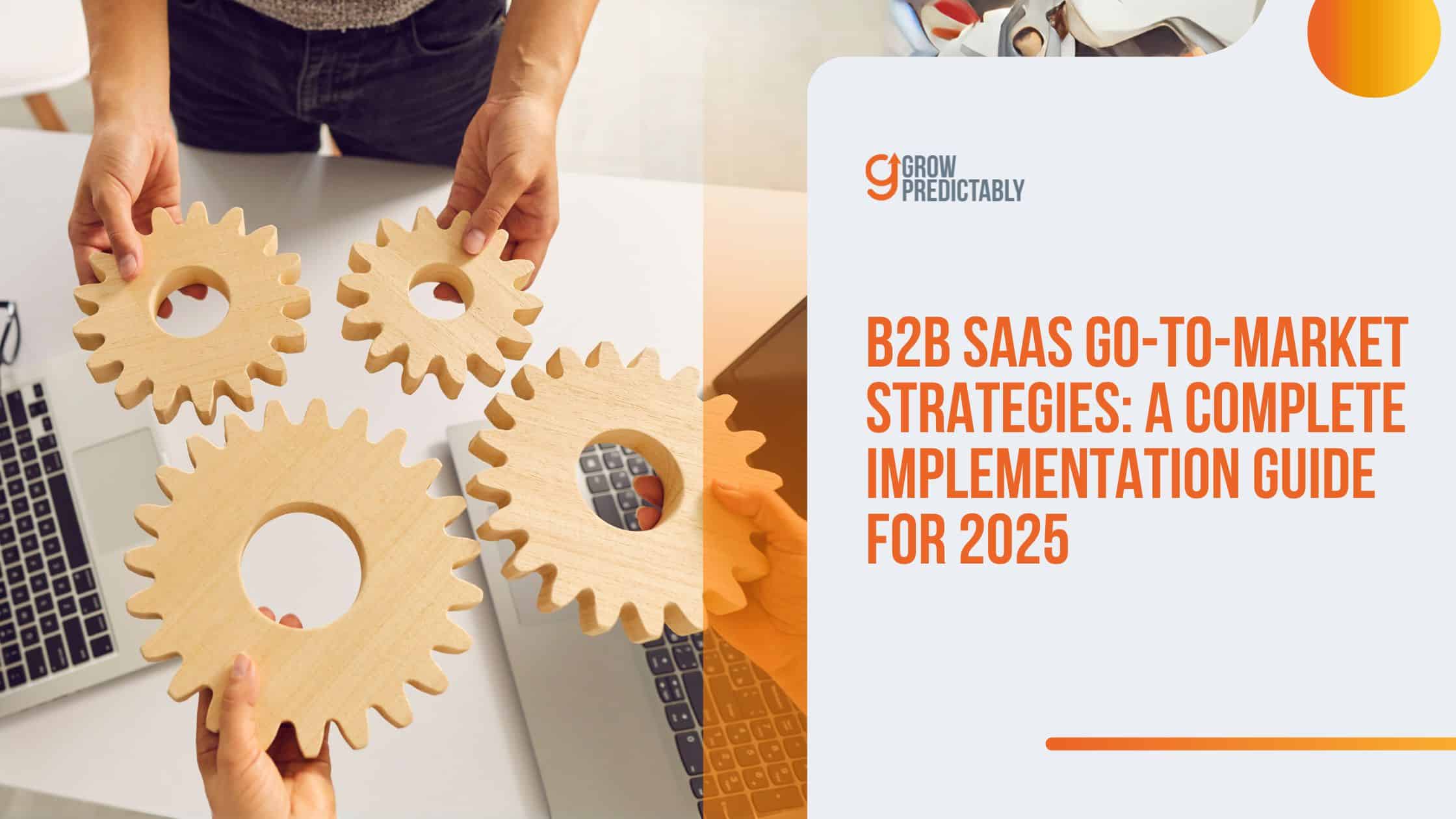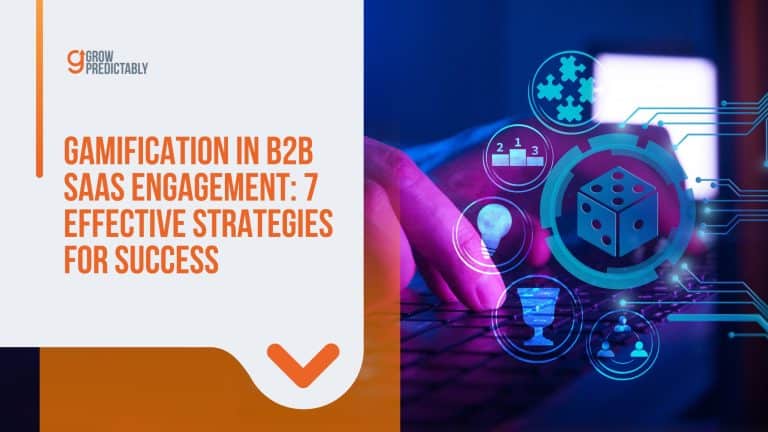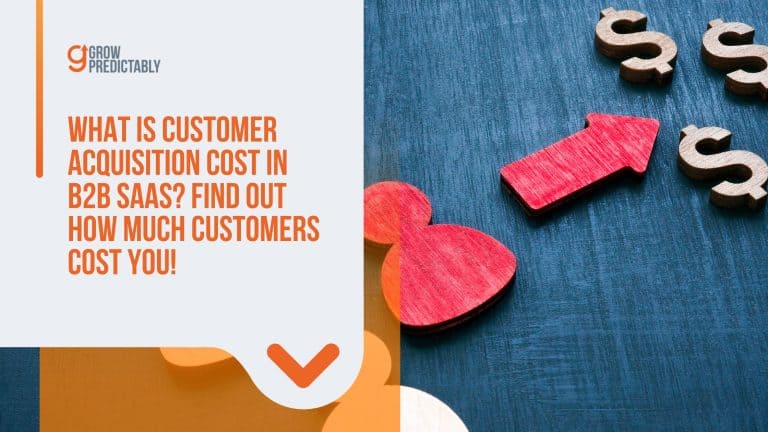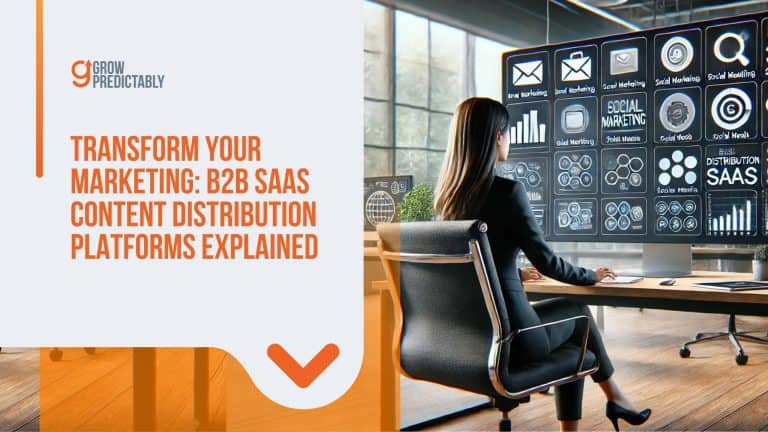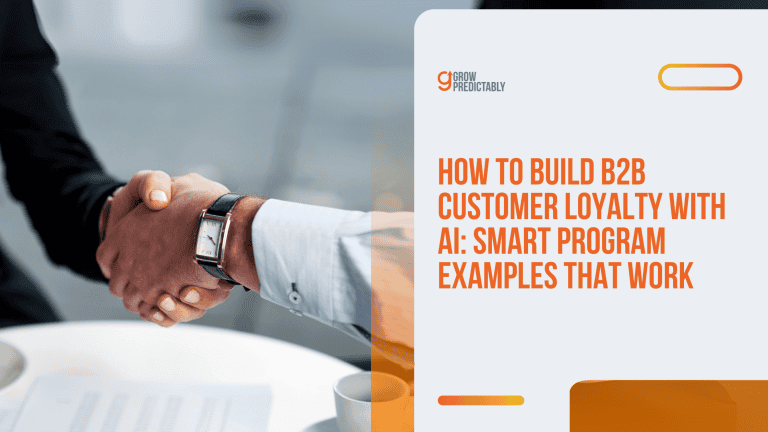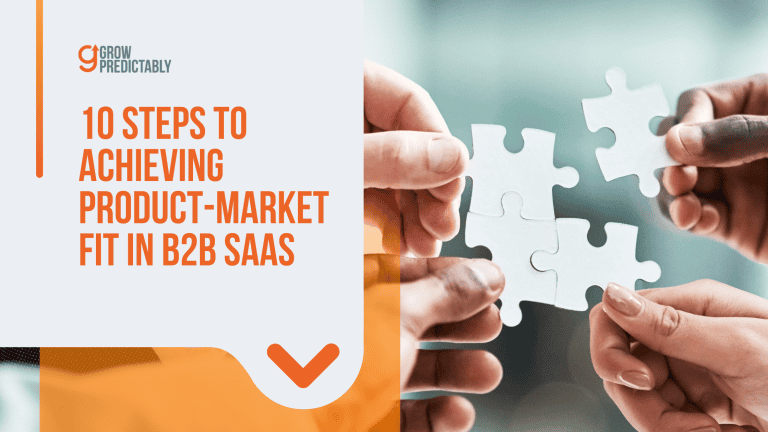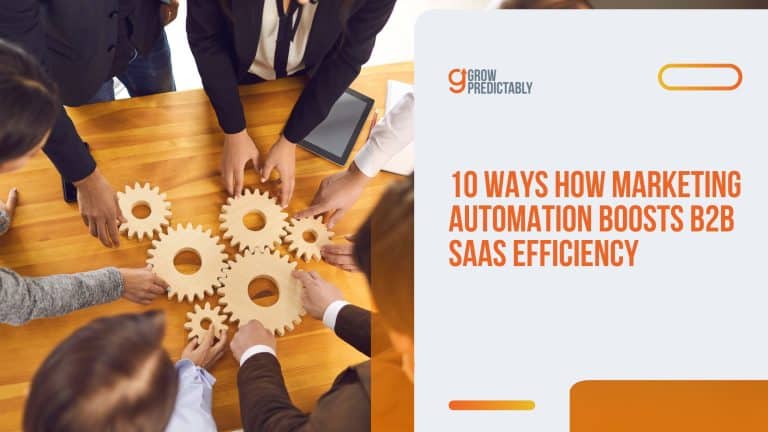B2B SaaS Go-to-Market Strategies: A Complete Implementation Guide for 2025
Let’s talk about B2B SaaS go-to-market strategies for a second.
Most struggle because they’re trying to sell to everyone instead of narrowing in.
I’ve made this mistake, and trust me—it’s expensive to fix.
The good news?
If you start right, you’ll save months (if not years) of wasted effort.
No fluff, just actionable advice.
Ready?
Let’s dive into the playbook.
1. Understanding the B2B SaaS Market (vs the B2C SaaS Market)
The cold, hard truth about B2B SaaS isn’t just in the numbers – it’s in the fundamentals that separate the winners from the losers.
According to OpenView Partners, B2B SaaS companies show a 76% higher survival rate in their first five years compared to their B2C counterparts.
This isn’t just luck or better funding – it’s built into the DNA of how B2B companies operate and generate revenue.
Let me break down exactly why B2B SaaS companies have this edge based on concrete market dynamics:
- Enterprise-grade contracts typically span 12-36 months, creating a fortress of predictable revenue that shields against market volatility and economic downturns. When you’re looking at $50,000+ annual contracts versus $50 monthly subscriptions, you’ve got a completely different level of stability.
- B2B customer acquisition costs (CAC) might be higher upfront, but the lifetime value (LTV) often exceeds B2C by 2-3x because businesses are willing to pay premium prices for solutions that directly impact their bottom line. This creates a more sustainable economic model.
- The B2B sales cycle operates on logic and ROI rather than emotion and impulse. While this means longer sales cycles (averaging 3-6 months), it also results in more stable, long-term customer relationships that aren’t swayed by market trends or competitor promotions.
But here’s what most founders miss: survival doesn’t equal success.
While you might stay afloat longer in B2B, the real game is about dominating your market segment.
The businesses that win in B2B SaaS understand that stability is just the foundation – it’s what you build on top of that foundation that determines whether you’ll become a category leader or remain just another player in a crowded market.
It takes 20 years to build a reputation and five minutes to ruin it. If you think about that, you’ll do things differently.
Warren Buffett
Here’s the reality check: that 76% survival rate means nothing if you’re barely growing at 20% year-over-year while your competitors are scaling at 100%+.
Success in B2B SaaS demands a relentless focus on understanding enterprise pain points, delivering measurable ROI, and building a product that becomes mission-critical to your customers’ operations.
2. What Works in B2B SaaS Market Research

The difference between success and failure in B2B SaaS market research isn’t about gathering more data – it’s about conducting thorough market research to gather the right data that drives revenue-generating decisions.
Here’s what separates multi-million dollar successes from costly failures.
Know Your Audience
B2B buying decisions aren’t made by individuals scrolling through Instagram; they are influenced by understanding the target audience.
They’re made by sophisticated teams with complex approval processes, strict compliance requirements, and ruthless ROI expectations.
According to Gartner’s research, the average B2B purchase now involves 11 individual stakeholders.
Here are the critical data points you need to dominate your market segmentation:
- Company Demographics: Revenue bands ($10M-50M, $50M-250M, $250M+), employee count thresholds (100-500, 500-2000, 2000+), and growth rates that indicate ideal customer profiles
- Industry Verticals: Specific sectors with the highest pain points, fastest time-to-value, and largest budgets for your solution
- Geographic Penetration: Markets with the right mix of regulatory environment, competitive landscape, and adoption readiness
- Decision Authority Matrix: Complete mapping of all stakeholders – from end-users to economic buyers to technical evaluators
Dig Into the Numbers
Raw market data becomes your competitive advantage when you know exactly where to look.
Enterprise market intelligence platforms reveal patterns that transform your go-to-market strategy:
- Growth Trajectory Analysis: According to SaaS Capital, top-performing B2B SaaS companies maintain 40%+ year-over-year growth rates by targeting expanding market segments
- Pricing Evolution Studies: Deep analysis of pricing models across your competitive landscape, including contract values, discounting patterns, and upsell frequencies
- Market Penetration Metrics: Detailed breakdown of market share by segment, showing exactly where the opportunities lie
Talk to Actual Customers
Customer interviews aren’t just feedback sessions – they’re gold mines of positioning data that transform your entire go-to-market strategy.
The key is extracting the insights that actually drive purchase decisions.
Critical areas to probe in every customer conversation:
- Current Tech Stack Analysis: Complete mapping of their existing solutions, integration points, and pain points with current vendors
- Budget Allocation Process: Exact understanding of their purchasing cycles, approval thresholds, and ROI requirements
- Feature Value Matrix: Detailed ranking of must-have vs nice-to-have features, including specific use cases and workflow impacts
- Switching Trigger Events: Precise identification of events that prompt evaluation of new solutions
Analyze Competitors
Surface-level competitor analysis is worthless.
True competitive intelligence requires systematic deconstruction of their entire business model:
- Product Architecture: Deep technical analysis of their solution’s capabilities, limitations, and scalability constraints
- Go-to-Market Playbook: Comprehensive mapping of their targeting strategy, sales methodology, and customer acquisition channels
- Customer Success Metrics: Detailed examination of their onboarding process, support infrastructure, and retention strategies
- Market Positioning Evolution: Historical analysis of how their messaging and target market have shifted over time
Every piece of research should drive concrete action.
Market research isn’t about creating pretty slide decks – it’s about uncovering specific opportunities that drive revenue growth.
Track everything, measure everything, and ruthlessly optimize based on real market feedback.
3. Turning Insights into Sales Messages
The B2B SaaS market reached $157 billion in 2023, but that number means nothing if you can’t translate market insights into revenue.
Let’s break down exactly how to transform raw data into messages that make enterprise buyers reach for their wallets.
Your market research reveals pain points – but pain points don’t close deals.
You need to transform those insights into a revenue-generating narrative that speaks directly to your buyer’s P&L statement and optimizes your marketing and sales efforts:
- Value Translation Framework: Convert feature benefits into hard dollar impact. When a CTO sees that your solution reduces infrastructure costs by 32% while increasing deployment speed by 3x, you’re speaking their language
- Decision-Maker Alignment Matrix: Map specific pain points to each stakeholder in the buying process – from the end-user’s daily frustrations to the CFO’s bottom-line concerns
- Competitive Edge Positioning: Weaponize your unique advantages into clear, quantifiable differentiators that make your solution the obvious choice
Market size means nothing without market relevance.
The winners in B2B SaaS don’t try to capture the entire market – they dominate specific segments where their solution creates undeniable value.
Here’s what separates winning sales messages from those that fall flat:
- Industry-Specific ROI Models: Custom-built financial models that show exactly how your solution impacts key performance metrics in each target vertical
- Implementation Success Stories: Concrete examples of similar companies achieving specific, measurable results with detailed breakdown of the implementation process
- Risk Mitigation Narrative: Clear articulation of how your solution addresses the specific security, compliance, and integration concerns of enterprise buyers
Remember: Enterprise buyers don’t want generic value propositions.
They need concrete evidence that your solution will deliver a measurable impact on their specific business challenges.
Every sales message should connect directly back to the pain points and opportunities you uncovered in your market research.
The next stage is turning these messages into a systematic sales process that consistently converts enterprise prospects into long-term customers.
But that process only works when it’s built on the foundation of deep market insights translated into compelling sales narratives.
4. Importance of a Strong Value Proposition
In B2B SaaS, the gap between success and failure often comes down to one thing: your value proposition.
Most founders build great products but fail because they can’t articulate value in a way that makes enterprise buyers act.
Let’s transform your value proposition from generic feature lists into a revenue-generating asset.
The Core Message Canvas Framework
The Core Message Canvas isn’t just another messaging framework – it’s a systematic approach to turning product features into compelling business value.
Step 1: Choose a Customer Avatar
Multi-million dollar deals aren’t closed with generic messaging.
Your value proposition must speak directly to specific decision-makers with real challenges and concrete objectives.
Key elements of a revenue-generating customer avatar:
- Detailed Role Profile: Full breakdown of their responsibilities, KPIs, and career objectives
- Pain Point Matrix: Comprehensive mapping of their daily operational challenges and strategic concerns
- Decision Authority Level: Clear understanding of their purchasing power and influence in the buying process
- Success Metrics: Specific KPIs they’re measured against and need to improve
Step 2: Map Out the Before/After Grid
Enterprise buyers don’t buy features – they buy transformation.
Your before/after grid must quantify the specific impact of implementing your solution:
- Operational Impact: Measurable improvements in efficiency, productivity, and resource utilization
- Financial Results: Hard dollar savings and revenue growth potential
- Risk Mitigation: Specific compliance, security, and operational risks addressed
- Strategic Advantage: Competitive edge gained through implementation
Step 3: Craft Your Value Statement
Your value statement must instantly connect with decision-makers and drive action.
The winning formula combines:
- Specific Outcome: Clear articulation of the end result
- Measurable Impact: Concrete metrics that prove ROI
- Time Frame: Defined period for achieving results
- Unique Advantage: Clear differentiation from alternatives
Step 4: Define Jobs-to-be-Done
Enterprise buyers need to understand exactly how your solution transforms their operations:
- Process Automation: Specific manual tasks eliminated or automated
- Integration Points: Seamless connections with existing systems
- Workflow Enhancement: Precise improvements to current processes
- Resource Optimization: Clear reduction in time, money, or manpower needed
Step 5: Use a Metaphor
Enterprise sales acceleration happens when complex value propositions become instantly understandable:
- Industry-Specific Comparisons: Metaphors that resonate with your target vertical
- Problem-Solution Parallels: Clear analogies that highlight your unique approach
- Value Visualization: Mental models that make benefits tangible
Step 6: Separate Canvases for Multiple Products
Product portfolio clarity drives enterprise sales velocity.
Each product needs:
- Distinct Value Matrix: Clear separation of use cases and benefits
- Target Segment Alignment: Specific buyer personas and industries
- Implementation Pathway: Defined integration and adoption process
- ROI Framework: Custom financial models for each solution
Remember: Enterprise buyers don’t have time to decode complex value propositions.
Your message must instantly connect your solution to their specific challenges and objectives.
The Core Message Canvas framework ensures every element of your value proposition drives toward a single goal: converting prospects into customers.
5. Utilizing Market Insights & Pricing Strategies
The price of greatness is responsibility.
Winston Churchill
Your market insights aren’t just research data – they’re your revenue blueprint.
When it comes to pricing, the difference between rapid growth and stagnation comes down to one thing: a well-executed GTM strategy that addresses specific market needs and achieves product-market fit.
Leveraging Market Intelligence
Market research becomes a profit multiplier when you use it to validate and refine your pricing strategy.
According to OpenView’s SaaS benchmarks, companies that regularly test and optimize pricing grow 30% faster than those who set and forget.
Critical components that drive pricing power:
- Value Perception Analysis: Deep understanding of how different market segments perceive and measure value
- Budget Authority Mapping: Clear breakdown of purchasing power and approval thresholds across customer segments
- Competitive Price Positioning: Strategic analysis of where your solution sits in the market value hierarchy
- Implementation Cost Structure: Detailed understanding of customer acquisition and service delivery costs
Main Pricing Models
- Subscription-Based
The backbone of B2B SaaS revenue.
According to ProfitWell, subscription-based models deliver 2-3x higher customer lifetime value compared to transactional models.
Essential elements for subscription success:
- Contract Length Optimization: Strategic balance between monthly and annual commitments
- Renewal Process Architecture: Systematic approach to maintaining and growing recurring revenue
- Expansion Revenue Triggers: Clear pathways for increasing customer spending over time

Just like Salesforce, it offers predictable pricing for customers to manage CRM needs efficiently.
- Tiered Pricing
Enterprise buyers demand flexibility.
Tiered pricing isn’t just about features – it’s about matching solution scope to business value:
- Feature-Value Alignment: Each tier must deliver clear, measurable additional value
- Upgrade Pathway Design: Seamless progression from basic to enterprise offerings
- Scale Economics: Pricing structure that rewards increased usage and adoption

One example of tiered pricing is HubSpot. HubSpot allows customers to scale their solutions by aligning with business growth.
The plans on their website even have sections “For business & enterprises” and “For individuals & small teams” to help each customer find the best plans they can scale with.
- Freemium Strategy
Freemium isn’t just a pricing model – it’s a market penetration strategy.
The key metrics that determine freemium success:
- Conversion Rate Optimization: Clear triggers that drive upgrade decisions
- Usage Threshold Analysis: Precise identification of value thresholds that justify paid features
- Support Cost Management: Sustainable economics for serving free users

Slack is one of the market’s widely known brands when freemiums are the topic.
Slack provides entry-level access for small teams, driving adoption and upsell opportunities.
- Usage-Based Pricing
Usage-based models align cost with value creation.
Essential components include:
- Usage Metric Selection: Choose metrics that directly correlate with customer value
- Predictability Features: Tools and analytics that help customers forecast costs
- Scale Discount Design: Volume pricing that encourages increased usage

One popular example of usage-based pricing is AWS (Amazon Web Services).
AWS ensures customers pay only for the computing resources they use, maximizing cost-effectiveness.

They even have an AWS Pricing Calculator at the bottom of their site to help gauge how much your subscriptions will cost you.
Strategic Price Optimization
Your pricing strategy must evolve with market conditions and customer value realization:
- Regular Price Testing: Systematic approach to testing price sensitivity across segments
- Value Metric Tracking: Continuous monitoring of how customers measure ROI
- Competitive Response Protocol: Strategic framework for responding to market pricing changes
- Customer Feedback Integration: Direct input from customers on price-value alignment
Perfect pricing doesn’t exist, but optimal pricing does.
The key is building a pricing strategy that captures fair value while driving customer acquisition and retention.
Test aggressively, measure relentlessly, and optimize continuously based on market response and customer feedback.
6. The Customer Value Journey in Building Your B2B SaaS Go-to-Market Strategies
Every B2B SaaS sale follows a clear path – from the first touch to loyal customers.
Different touchpoints create different types of value.
Here’s how to maximize each stage with the CVJ as a guide.

1. Awareness: Getting on Their Radar
Your potential customers aren’t looking for your product – they’re looking for solutions to their problems.
Win their attention by:
- Targeted LinkedIn content that speaks to specific pain points
- SEO-optimized content that answers their burning questions
- Strategic ad placement where your buyers actually spend time
2. Engagement: Keeping Their Interest
Once you have their attention, you need to keep it.
Focus on:
- Quick-win content that delivers immediate value
- Real customer stories that prove your impact
- Direct engagement that builds relationships
3. Subscription: Getting That First “Yes”
Make it brain-dead simple to take the first step:
- One-click assessment tools
- Instant-value calculators
- Minimal-field forms that respect their time
4. Conversion: Turning Interest Into Revenue
The path to purchase must be smooth and logical:
- Focused demos that solve specific problems
- Risk-free trials that prove value
- Clear ROI calculations that justify investment
5. Excitement: Preventing Buyer’s Remorse
The first 24 hours after purchase are critical:
- Personal welcome from a real human
- Quick-win implementation guide
- Clear path to first value realization
6. Ascension: Growing Customer Value
Smart upsell strategies that align with customer growth:
- Feature packages that scale with usage
- Strategic upgrade paths
- Value-based expansion opportunities
7. Advocacy: Creating Vocal Supporters
Turn happy customers into revenue multipliers:
- Milestone-based advocacy programs
- Strategic case study development
- VIP access to new features
8. Promotion: Weaponizing Word of Mouth
Make it profitable for customers to promote you:
- Simple referral systems
- Clear reward structures
- Exclusive promoter benefits
Channel Integration Strategy
Your channels must work together like a well-oiled machine:
- Content Cross-Pollination: Each piece leads naturally to the next
- Data Integration: Complete view of customer journey across touchpoints
- Consistent Messaging: Clear value proposition at every stage
Real-World Impact
Let’s look at what this means in dollars and cents:
- Reduced Customer Acquisition Cost (CAC): Focused spending on channels that actually convert
- Increased Customer Lifetime Value (CLV): Strategic upsell and cross-sell opportunities
- Higher Net Revenue Retention (NRR): Stronger customer relationships that grow over time
The customer journey isn’t linear anymore.
Build your systems to capture and convert customers wherever they enter your ecosystem. Test everything, measure what matters, and optimize based on real revenue impact.
7. Tools and Technologies for B2B SaaS Success
An organization’s ability to learn, and translate that learning into action rapidly, is the ultimate competitive advantage.
Peter Drucker
In 2024, your tech stack isn’t just a collection of tools – it’s your competitive advantage.
Let’s break down the exact tools and technologies that drive B2B SaaS growth.
Marketing Automation That Drives Revenue
Marketing automation transforms manual tasks into scalable revenue streams by optimizing marketing efforts.
According to Nucleus Research, companies using marketing automation see a 14.5% increase in sales productivity.
Key capabilities that drive results:
- Lead Scoring Intelligence: Automated identification of high-value prospects
- Behavior Tracking: Real-time monitoring of prospect engagement
- Campaign Orchestration: Synchronized multi-channel outreach
- Performance Analytics: Clear ROI tracking for every campaign
CRM: Your Revenue Command Center
Your CRM should accelerate deals, not create busy work.
Essential features for B2B success:
- Pipeline Visualization: Clear view of deal progress and revenue forecasting
- Activity Automation: Automated logging of prospect and customer interactions
- Integration Capabilities: Seamless connection with other revenue tools
- Mobile Functionality: Full access for teams on the move
Customer Success Technology
Modern customer success platforms turn customer data into retention revenue:
- Usage Analytics: Deep insights into product adoption and engagement
- Health Scoring: Early warning system for at-risk accounts
- Automated Touchpoints: Scalable customer engagement
- Expansion Triggers: Clear signals for upsell opportunities
Integration Architecture
Your tech stack needs to function as a single revenue engine:
- Data Flow Design: Clean, automated data movement between systems
- Workflow Automation: Elimination of manual handoffs
- Analytics Integration: Single source of truth for all revenue metrics
- Scalability Planning: Architecture that grows with your business
Tool Selection Strategy
Pick tools that match your specific business needs:
- Team Size Alignment: Solutions that scale with your growth
- Budget Optimization: Maximum value for the current stage
- Implementation Resources: Required support for successful deployment
- ROI Timeline: Clear path to value realization
Tools should make your team more effective, not create additional work.
Focus on solutions that directly impact revenue generation and customer satisfaction. Measure tool ROI religiously, and don’t hesitate to change when something isn’t delivering value.
8. Measuring Success in B2B SaaS
Data without action is just noise.
Let’s break down the exact metrics that drive growth and how to turn them into revenue-generating decisions.
Core Performance Metrics
Your metrics should tell you three things: what’s working, what’s not, and what to fix first.
According to OpenView Partners, companies that regularly track and optimize these core metrics grow 2x faster than those that don’t.
Must-Track KPIs:

- Customer Acquisition Cost (CAC): Total spend to acquire each customer
- Time to Revenue: Days from first touch to first payment
- Stage Conversion Rates: Success rates at each pipeline stage
- Customer Lifetime Value (CLV): Total revenue per customer
- Net Promoter Score (NPS): Customer satisfaction and loyalty metric
Action-Oriented Analytics
Your data needs to drive immediate action.
Build your analytics system around:
- Weekly Performance Reviews: Regular check-ins on core metrics
- Root Cause Analysis: Deep dives into metric changes
- Rapid Response Protocol: Clear process for addressing issues
- Success Pattern Recognition: Quick identification of what’s working
Dashboard Design for Revenue Growth
Your dashboard should be a revenue acceleration tool:
- Real-Time Metrics: Current performance against targets
- Trend Visualization: Clear patterns in key metrics
- Alert Triggers: Automatic flags for metric changes
- Team Performance Views: Individual and group metrics
Optimization Framework
Turn your metrics into systematic improvements:
- Issue Identification: Clear process for spotting problems
- Solution Testing: Structured approach to fixes
- Impact Measurement: Precise tracking of changes
- Success Documentation: Recording what works
The best metrics system is one your team actually uses.
Make it simple, make it actionable, and make it drive real results. Update it regularly and use it to guide every major business decision.
FAQs
Turning Strategy Into Revenue
A solid go-to-market strategy isn’t just a plan – it’s your roadmap to sustainable revenue growth.
Let’s crystallize everything we’ve covered into actionable steps that drive real results by aligning your sales efforts with detailed audience research and market analysis.
Your B2B SaaS success comes down to nailing these core elements:
- Deep Market Understanding: Know exactly who buys and why
- Value-Based Pricing: Capture the true worth of your solution
- Systematic Sales Process: Repeatable path to closing deals
- Metrics-Driven Optimization: Continuous improvement based on real data
Start with these high-impact moves:
- Customer Research: Talk to 10 ideal customers this week
- Value Proposition Testing: Run small tests of different messaging
- Sales Process Documentation: Map out your exact sales steps
- Performance Tracking: Set up basic metrics monitoring
While others guess, you’ll know:
- Exactly who your best customers are
- What makes them buy
- How to find more of them
- When to adjust your strategy
Remember: Success in B2B SaaS isn’t about perfection – it’s about systematic improvement.
Start with the basics, measure what matters, and optimize based on real results.
Your go-to-market strategy should evolve with your business and your market.
Collaborate closely with your sales team to ensure these strategies are effectively implemented.
The companies that win aren’t always the ones with the best product – they’re the ones that best understand and serve their market.
A well-organized sales team can optimize relationships with prospects and effectively convert leads.
Put these principles into action and you’ll build a sustainable competitive advantage that drives long-term growth.
Aligning your sales teams towards shared goals will enhance overall effectiveness and drive revenue for both new enterprise and self-service products.

